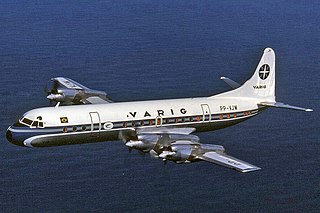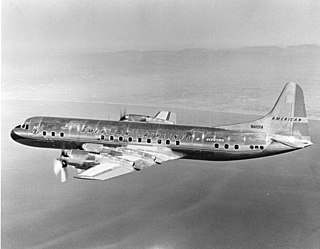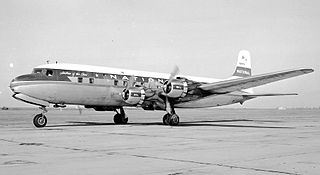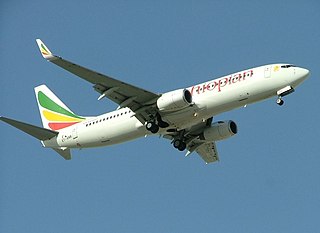
China Airlines Flight 611 (CI611/CAL611) was a regularly scheduled passenger flight from Chiang Kai-shek International Airport in Taiwan to Hong Kong International Airport in Hong Kong. On 25 May 2002, the Boeing 747-209B operating the route disintegrated in midair and crashed into the Taiwan Strait, 23 nautical miles northeast of the Penghu Islands, 20 minutes after takeoff, killing all 225 people on board. The in-flight break-up was caused by metal fatigue cracks resulting from improper repairs to the aircraft 22 years earlier. As of 2024, the crash remains the deadliest in Taiwanese history, as well as the most recent accident with fatalities involving China Airlines, and the second-deadliest accident in China Airlines history, behind China Airlines Flight 140.

The Lockheed L-188 Electra is an American turboprop airliner built by Lockheed. First flown in 1957, it was the first large turboprop airliner built in the United States. Initial sales were good, but after two fatal crashes that led to expensive modifications to fix a design defect, no more were ordered. With its fairly high power-to-weight ratio, huge propellers and very short wings, large Fowler flaps which significantly increased effective wing area when extended, and four-engined design, the airplane had airfield performance capabilities unmatched by many jet transport aircraft even today—particularly on short runways and high field elevations. Jet airliners soon supplanted turboprops for many purposes, and many Electras were modified as freighters. Some Electras are still being used in various roles into the 21st century. The airframe was also used as the basis for the Lockheed P-3 Orion maritime patrol aircraft.
This is a list of aviation-related events from 1960.

On December 16, 1960, a United Airlines Douglas DC-8 bound for Idlewild Airport in New York City collided in midair with a TWA Lockheed L-1049 Super Constellation descending toward LaGuardia Airport. The Constellation crashed on Miller Field in Staten Island and the DC-8 in Park Slope, Brooklyn, killing all 128 aboard the two aircraft and six people on the ground. The accident was the world's deadliest aviation disaster at the time, and remains the deadliest accident in the history of United Airlines.

American Airlines Flight 320 was a scheduled flight between Chicago Midway International Airport and New York City's LaGuardia Airport. On February 3, 1959, the Lockheed L-188 Electra performing the flight crashed into the East River during its descent and approach to LaGuardia Airport, killing 65 of the 73 people on board. Weather conditions in the area were poor, which meant that the crew had to descend through dense clouds and fog. The aircraft flew lower than the pilots intended and it crashed into the icy river 4,900 feet (1,500 m) short of the runway at a speed of 140 knots. American Airlines had been flying the newly-developed Lockheed Electra in commercial service for only about two weeks before the accident.

National Airlines Flight 2511 was a United States domestic passenger flight from New York City to Miami, Florida. On January 6, 1960, the Douglas DC-6 serving the flight exploded in midair. The National Airlines aircraft was carrying 5 crew members and 29 passengers, all of whom perished. The Civil Aeronautics Board investigation concluded that the plane was brought down by a bomb made of dynamite. No criminal charges were ever filed, nor was the blame for the bombing ever determined, though a suicide bombing is suspected. The investigation remains open.
Northwest Airlines Flight 2 was a Lockheed Super Electra aircraft, registration NC17388, which crashed into the Bridger Mountains in Gallatin County, Montana, about twelve miles (20 km) northeast of Bozeman, on January 10, 1938. All ten on board were killed in the accident, which was the first fatal crash of a Lockheed Super Electra and of a Northwest Airlines aircraft.

LANSA Flight 502 was a Lockheed L-188A Electra operated by Líneas Aéreas Nacionales Sociedad Anónima (LANSA) which crashed shortly after takeoff from Quispiquilla Airport near Cusco, Peru, on August 9, 1970, after losing all power from one of its four engines. The turboprop airliner, registered OB-R-939, was bound from Cusco to Lima, carrying 8 crew and 92 passengers. All but one of the occupants died from injuries sustained from impact forces and post crash fire. Two people on the ground were also killed. There were 49 American high school exchange students on board, all of whom perished. A Peruvian government investigation concluded that the accident was caused by improper execution of engine-out procedures by the flight crew and lack of proper maintenance. LANSA was fined and its operations were suspended for 90 days. At the time, the crash was the deadliest ever in Peruvian history before being surpassed by Faucett Perú Flight 251 in 1996.

Eastern Air Lines Flight 375, registration N5533, was a Lockheed L-188 Electra aircraft that crashed on takeoff from Logan International Airport in Boston, Massachusetts, on October 4, 1960. Ten survived, nine with serious injuries, but 62 of 72 on board were killed in the accident. It remains the deadliest bird strike in aviation history.

Northwest Orient Airlines Flight 706 was a Lockheed L-188 Electra aircraft, registration N137US, which crashed on take-off from Chicago's O'Hare International Airport September 17, 1961. All 37 on board were killed in the accident.

LOT Polish Airlines Flight 007 was an Ilyushin Il-62 that crashed near Okęcie Airport in Warsaw, Poland, on 14 March 1980, as the crew aborted a landing and attempted to go-around. All 87 crew and passengers died. It was caused by the disintegration of one of the turbine discs in one of the plane's engines, leading to uncontained engine failure. The turbine disc was later found to have manufacturing faults.

The Grand Canyon mid-air collision occurred in the western United States on June 30, 1956, when a United Airlines Douglas DC-7 struck a Trans World Airlines Lockheed L-1049 Super Constellation over Grand Canyon National Park, Arizona. The first one fell into a canyon and the other one slammed into a rock face. All 128 on board both airplanes perished, making it the first commercial airline incident to exceed one hundred fatalities. The airplanes had departed Los Angeles International Airport minutes apart from each other and headed for Chicago and Kansas City, respectively. The collision took place in uncontrolled airspace, where it was the pilots' responsibility to maintain separation. This highlighted the antiquated state of air traffic control, which became the focus of major aviation reforms.

TWA Flight 529 was a Lockheed Constellation L-049 propliner, registration N86511, operating as a scheduled passenger service from Boston, Massachusetts to San Francisco, California. On September 1, 1961, at 02:05 CDT, the flight crashed shortly after takeoff from Midway Airport in Chicago, killing all 73 passengers and five crew on board; it was at the time the deadliest single plane disaster in U.S. history.

Caspian Airlines Flight 7908 was a scheduled commercial flight from Tehran, Iran, to Yerevan, Armenia, that crashed near the village of Jannatabad, outside the city of Qazvin in north-western Iran, on 15 July 2009. All 153 passengers and 15 crew on board died.

Braniff International Airways Flight 542, a Lockheed L-188 Electra, registration N9705C, was a scheduled domestic flight from Houston, Texas, bound for New York with scheduled stops in Dallas and Washington, D.C. On September 29, 1959, 23 minutes into the 41-minute flight from Houston to Dallas Love Field, the aircraft disintegrated in mid-air approximately 3.8 miles (6.1 km) southeast of Buffalo, Texas, killing everyone on board.

Ethiopian Airlines Flight 409 was an international commercial flight scheduled from Beirut to Addis Ababa that crashed into the Mediterranean Sea shortly after takeoff from Rafic Hariri International Airport on 25 January 2010, killing all 90 people on board. This was the first fatal crash for Ethiopian Airlines since the hijack of Ethiopian Airlines Flight 961 in 1996.

American Flyers Airline Flight 280/D was a flight operated on a U.S. Military Air Command contract from Monterey Regional Airport in California to Columbus Airport in Georgia, via Ardmore Municipal Airport, Oklahoma. On April 22, 1966, while approaching Runway 8 at Ardmore, the aircraft overshot the runway and crashed into a hill, bursting into flames. Eighty-three of the 98 passengers and crew on board died as a result of the accident.

Air Manila Flight 702 was an unscheduled passenger flight from Naval Air Station Agana in Guam to Ninoy Aquino International Airport in Manila, carrying 33 passengers and 12 crew members; most of whom were personnel from the base. The Lockheed L-188A Electra attempted takeoff from runway 6L but crashed near a residential area; the crash was caused by retracting the flaps at an altitude too low to clear the terrain after the propeller of engine number three feathered. All 45 people on board and one person on the ground perished in the crash. The investigation concluded that the pilot should have followed company policy by aborting takeoff in the event of an engine failure before reaching VR (takeoff) speed.


















